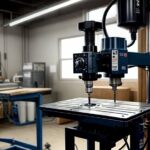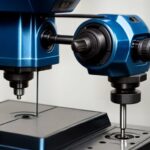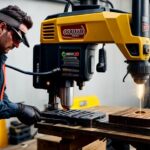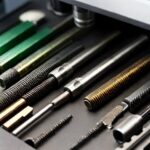Have you ever wondered whether a mortising bit may be used in a drill press? Although it is a convenient and cost-effective alternative, several critical considerations exist before doing this job.
In this blog article, we’ll look at how mortising bits work with drill presses, the benefits and drawbacks of doing so, and the measures you should take to guarantee safety and precision. Thus, if you’re considering utilizing a mortising bit in your drill press, read on to learn all you need to know.
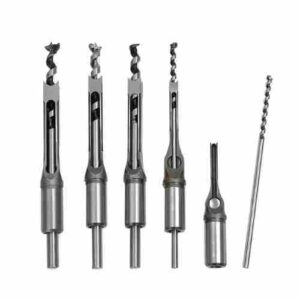 What is a mortising bit?
What is a mortising bit?
A mortising bit is a cutting tool to make square or rectangular holes in wood. These mortises are often used to accommodate tenons, which create a junction between two pieces of wood. Mortising bits are compatible with various woodworking instruments, such as mortising machines, routers, and drill presses.
They come in various sizes and forms, with varying cutting depths and widths to suit various needs. Woodworkers who must make strong, lasting connections in their creations, such as furniture, cabinets, and doors, typically employ mortising bits.
Can I use a mortising bit in a drill press?
Yes, a mortising bit may be used in a drill press. Yet, there are several critical considerations to make before doing this sort of job.
First, drill presses are mostly intended for drilling holes, while mortising machines and routers are largely intended for making mortises. A unique mechanism in mortising machines and routers enables the bit to travel up and down while cutting, resulting in a clean and precise mortise. Since a drill press lacks this mechanism, obtaining the same degree of precision might be difficult when using a mortising bit.
Second, unlike drill bits, mortising bits are normally meant to be used at considerably slower rates. Using a mortising bit at high drill press speeds may cause the bit to overheat and become damaged, which is unsafe.
Lastly, utilizing a mortising bit in a drill press demands a high level of ability and knowledge to produce an exact and safe mortise cut. Using a mortising bit in a drill press incorrectly might result in injury, equipment damage, or faulty results.
How do I mortise an attachment on a drill press?
- Choose the appropriate attachment: Drill press mortising accessories are available. These accessories are meant to fit onto the drill press’s quill and have a square chisel that can be adjusted for breadth and depth.
- Adjust the chisel: Adjust the chisel to the desired mortise width and depth. The attachment should be centered on the chisel.
- Secure the workpiece: Firmly clamp the workpiece to the drill press table. This keeps it from shifting throughout the mortising process.
- Change the depth stop: Set the drill press’s depth stop to the mortise depth. This will prevent the chisel from digging too far into the workpiece and ruining it.
- Start the drill press: Start the drill press and set the speed to a medium setting.
- Begin mortising by lowering the attachment onto the workpiece and aligning the chisel with the mortise. Lower the chisel into the workpiece using the attachment’s handle. To cut the mortise, apply hard and consistent pressure to the handle.
- Lift the chisel and remove the waste from the mortise using a chisel or mortising bit.
- Continue the technique until you have the appropriate number of mortises.
- Finish the mortise by sanding it and removing any extra wood for a smooth finish.
Advantages:
The following are some possible benefits of utilizing a mortising bit in a drill press:
- Cost-effectiveness: Utilizing a drill press with a mortising bit might be less expensive than purchasing a specialist mortising machine or router, particularly if you need to produce a few mortises.
- Versatility: A drill press may be used for various activities, including drilling holes, sanding, and shaping wood. You may add mortising to the number of activities you can do with your drill press by utilizing a mortising bit.
- Convenience: If you already possess a drill press, utilizing a mortising bit is a simple way to add mortising capabilities to your workplace without purchasing extra equipment.
- Control: Using a drill press to make mortises may give you more control and accuracy, mainly if you use a mortising jig to guide the bit.
- Speed: For producing tiny or shallow mortises, a drill press may be quicker than a mortising machine or router since it is easy to rapidly alter the cut’s depth and replace the bit.
Disadvantages:
- Safety concerns: If necessary safety procedures are not followed, using a mortising bit in a drill press may be harmful. The drill press’s high speed and the possibility of backlash might result in injury or damage to the equipment.
- Restricted precision: Since mortising machines and routers lack particular mechanisms, it might be difficult to attain the same accuracy when using a mortising bit in a drill press. This may lead to loose joints and reduced structural integrity.
- Drill press damage: The high speed and torque necessary for cutting mortises may create significant wear and tear on the drill press, resulting in damage or expensive repairs.
- Restricted bit selection: Since most drill presses have a limited range of shank diameters that can be accommodated, the choice of mortising bits that can be utilized is limited.
- Difficulty of use: Using a mortising bit in a drill press demands a high degree of ability and experience to produce correct results. This may be difficult for inexperienced woodworkers or those who have never used a drill press.
Precautions to take when using a mortising bit in a drill press:
While utilizing a mortising bit in a drill press, numerous measures must be taken to protect your safety and the correctness of your job. These are some measures to take:
- Use safety equipment: While using a drill press and mortising bit, always wear eye protection, ear protection, and a dust mask. This will shield you from flying debris and dangerous dust.
- Secure your workpiece: Before cutting the mortise, make sure your workpiece is properly attached to the drill press table. This keeps the workpiece from shifting or sliding during cutting, which might result in erroneous cuts or harm.
- Employ a mortising jig: A mortising jig may help guide the mortising bit and guarantee correct cuts. This also reduces the possibility of kickback or the bit breaking.
- Work at a slow speed: Mortising bits are intended to be used at slower speeds than drill bits. When using a mortising bit, utilize the slowest speed on your drill press to avoid overheating and bit damage.
- Begin with a shallow cut: Make a shallow cut to determine the form and size of the mortise. Next, in tiny increments, deepen the depth of the incision until the required depth is reached.
- Remove debris: Clean debris from the mortise and drill press regularly to minimize accumulation, which may damage accuracy and raise the risk of injury.
- Use right technique: When using a mortising bit in a drill press, always employ the proper technique. This involves keeping a strong hold on the workpiece and the drill press, operating the drill press with both hands, and keeping your fingers away from the rotating bit.
Frequently Asked Questions (FAQs)
What is the primary purpose of a mortising bit?
A mortising bit is a cutting tool designed to make square or rectangular holes in wood. These mortises are often used to accommodate tenons, creating a strong joint between two pieces of wood. Mortising bits are commonly used by woodworkers for projects like furniture, cabinets, and doors.
Can I use a mortising bit with any drill press?
Yes, you can use a mortising bit with a drill press, but there are certain considerations to keep in mind. The drill press should have the capability to run at slower speeds, as mortising bits are designed to be used at lower speeds than regular drill bits. Additionally, you should use a mortising attachment or a mortising jig to ensure accuracy and safety.
Is using a mortising bit in a drill press as accurate as using a dedicated mortising machine?
Using a mortising bit in a drill press can be less accurate than using a dedicated mortising machine or a router, as these tools have specific mechanisms for creating clean and precise mortises. However, with proper technique, a mortising jig, and appropriate safety precautions, you can still achieve satisfactory results using a mortising bit in a drill press.
What safety precautions should I take when using a mortising bit in a drill press?
To ensure safety while using a mortising bit in a drill press, always wear eye protection, ear protection, and a dust mask. Secure your workpiece firmly to the drill press table, use a mortising jig to guide the bit, work at a slow speed, begin with shallow cuts, and regularly remove debris from the mortise and drill press.
Can I use a mortising bit with a handheld drill?
Using a mortising bit with a handheld drill is not recommended, as it can be challenging to control and maintain the accuracy needed for creating mortises. A drill press or dedicated mortising machine is better suited for this task, as they provide more stability and control during the mortising process.
FInal Words:
Using a mortising bit in a drill press is feasible, but various considerations exist. Using a mortising bit in a drill press has benefits such as cost-effectiveness and ease, but it also has drawbacks such as safety problems and restricted precision.
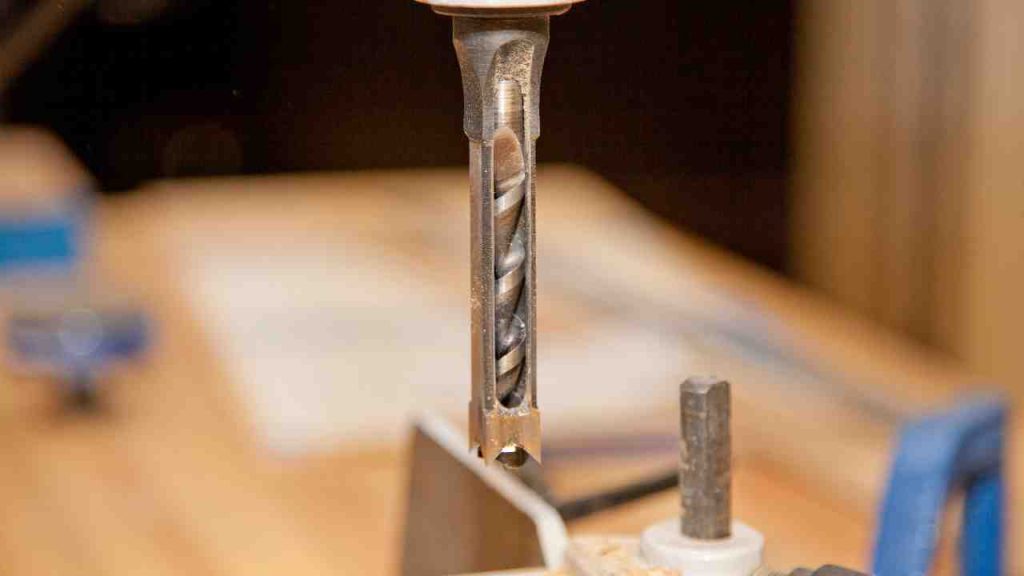
Utilizing a mortising bit in a drill press is ultimately determined by the individual’s skill level, experience, and project needs. Taking the required precautions and exercising good technique while using a mortising bit in a drill press is essential.
- Where are WEN drill presses made? - April 2, 2023
- Where are Rikon drill presses made? - April 1, 2023
- Where are Powermatic drill presses made? - April 1, 2023


